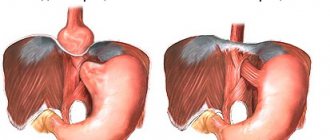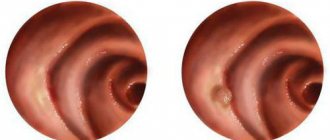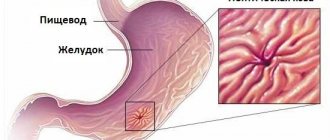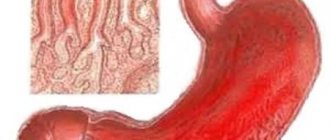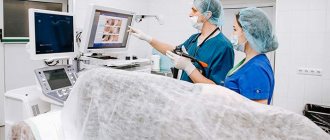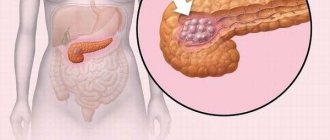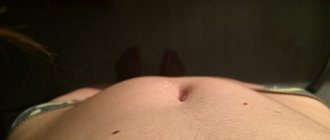Classification of pathology
Mallory-Weiss syndrome has a classification based on the severity of ruptures in the esophageal wall, which can be determined using fibrogastroscopy:
- Stage I – there are small cracks in the mucous membrane of the esophagus, mainly in its lower third, near the transition to the stomach. The bleeding is insignificant (most often F3).
- Stage II - there is a rupture of not only the mucous membrane, but also the submucosal layer of the esophagus (F1b or F1c).
- Stage III - rupture of the esophageal muscles (F1a, F1c and F1d) occurs.
- Stage IV - rupture of all walls of the esophagus (perforation), leading to the development of severe complications - peritonitis, mediastenitis, hemothorax (F1a and F1d).
The classification of Mallory-Weiss syndrome according to the severity of bleeding (established after fibrogastroscopy), which is also applicable for other gastrointestinal bleeding, is also of important diagnostic importance:
- Bleeding F1 – indicates that bleeding is still ongoing. In turn, it is divided into the following subgroups:
- F1a – severe bleeding from a ruptured wall of the esophageal artery.
- F1b – diffuse, capillary bleeding, usually not very strong, which is noted at the edge of the crack in the mucous membrane.
- F1c – there are blood clots at the site of the ruptures (the bleeding has almost stopped), but there is slight bleeding at the edges of the clot.
- F1d – bleeding is so severe that it is impossible to determine its location. It is observed with severe arterial and multiple diffuse capillary bleeding.
- Complete bleeding is designated F2, which also has several subgroups:
- F2a – endoscopy reveals a thrombus in a mucosal rupture.
- F2b - at this stage, a blood clot is detected in a fissure in the mucous membrane of the esophagus, but there is no bleeding.
- F2c – this stage is characterized by the inclusion of hemosiderin (blood that has come into contact with stomach acid) in the ruptures of the mucosa.
- There is also a group F3, in which no bleeding is detected. With it, the surgeon reveals only cracks in the mucosa, or an already healing area with fibrin.
Mallory-Weiss syndrome is extremely rare in children. When it occurs, the main development factors are acute poisoning, congenital anomalies of intestinal development, and acquired hernias.
Emergency care for Mallory-Weiss syndrome
The correctness of actions determines how quickly a person will recover after bleeding. First aid must be provided professionally and without delay.
If gastroesophageal rupture-hemorrhagic syndrome occurs, the following must be done before doctors arrive:
- Provide the patient with complete rest. Any action will only increase the bleeding.
- Apply ice to your stomach. Cold causes blood vessels to spasm, which stops bleeding.
- If there is a urge to vomit, the patient is given drugs with an antiemetic effect, for example, Cerucal or Metoclopramide.
Causes
The occurrence of this syndrome always has prerequisites. This disease does not just happen. The main causes of Mallory-Weiss syndrome include:
- Chronic and sometimes acute alcohol abuse. This is the main cause of the development of Mallory-Weiss syndrome. Very often, patients arrive at the emergency department in a state of severe alcohol intoxication.
- Other causes that cause this disease in 5-10% of cases are caused by chronic diseases of the stomach and esophagus. These gastrointestinal conditions include:
- hiatal hernia (HH),
- peptic ulcer of the stomach and duodenum,
- cirrhosis of the liver,
- pancreatic diseases,
- Crohn's disease.
- Heavy smokers develop chronic obstructive pulmonary disease, which is characterized by a severe cough. With prolonged and severe coughing, rupture of the esophagus and stomach mucosa can also occur. We can say that smoking indirectly affects the development of this syndrome.
A special pathogenesis (path of development) of Mallory-Weiss syndrome occurs in liver cirrhosis, which causes portal hypertension. The latter, in turn, causes varicose veins of the esophagus, the anterior wall of the abdomen and the rectum.
These vessels, if left untreated, as well as with ongoing alcoholism or drug addiction, are susceptible to damage and rupture, which often leads to death.
The etiology (reason) for the development of Mallory-Weiss syndrome in children is somewhat different. In a child, mucosal rupture can occur when:
- repeated uncontrollable vomiting due to food poisoning,
- high temperature (for infections),
- after crying for a long time,
- and much less often in diseases of the digestive system.
Mallory-Weiss syndrome - what is it?
This pathology was first described by S. Weiss and K. Mallory. That's why the syndrome got its name. This disease is one of the most common causes of non-ulcer bleeding that occurs in the upper digestive system. Mallory-Weiss syndrome is diagnosed in men 7 times more often than in women. At the same time, males aged 45-60 years who abuse alcoholic beverages are at increased risk. Pathology is diagnosed much less frequently in children.
Mallory-Weiss pathology syndrome, taking into account the size of the lesion, is of the following types:
- small (up to 10 mm);
- medium (10-30 mm);
- large (more than 30 mm).
The following stages of pathology are distinguished:
- Initial
– only the top layer of the mucosa is damaged. In this case, self-healing often occurs, or subcardial ulcers appear at the site of the ruptures. - Moderate severity
- the mucous and submucosal layer is affected. As a result of this pathological process, blood vessels are destroyed, which provokes bleeding. - Severe
– all the linings of the stomach and esophagus are damaged.
Mallory-Weiss syndrome - causes
There are many factors that provoke the development of this pathology.
Gastroesophageal rupture hemorrhagic syndrome may have the following causes:
- vomiting caused by toxicosis during pregnancy, overeating or alcohol abuse;
- coughing;
- abdominal injuries;
- alcohol abuse;
- hiccups;
- a hernia that occurs at the esophageal opening of the diaphragm.
Mallory-Weiss syndrome in children is provoked by the following factors:
- binge eating;
- esophagitis and other gastrointestinal pathologies that occur in a chronic form;
- diseases of the cardiovascular system.
Why is Mallory-Weiss syndrome dangerous?
If the necessary measures are not taken in time, the situation will worsen.
Mallory-Weiss syndrome is fraught with the development of the following complications:
- heart attack;
- peritonitis;
- hypoxia;
- ischemic myocardium;
- perforation of the mucosa at the site of rupture;
- severe pain in the chest area;
- fatal.
Symptoms
With Mallory-Weiss syndrome, regardless of the reasons that caused it, the main symptoms are blood in the vomit and retching.
In case of massive bleeding, the vomit consists entirely of blood, both fresh and associated with stomach acid (it is black).
Symptoms such as abdominal pain, weakness , loss of consciousness, and shock with massive blood loss also often occur. Since Melory-Weiss syndrome is characterized by bleeding of varying intensity, the general condition of the patient depends on the level of blood loss.
Diagnostics
Diagnosis of Mallory-Weiss syndrome is based on endoscopic findings. Endoscopy of the digestive tract is the main and most informative research method, which allows you to see the line of rupture of the digestive tract, determine the nature of the lesion, make a diagnosis and begin treatment.
In Mallory-Weiss syndrome, a linear fissure in the mucous membrane of the upper part of the stomach is detected. Typically, patients have one rupture. In extremely rare cases there may be 2 or more. The lesion is about 3 cm long and the distance between the edges of the crack is several mm. If a bleeding vessel is detected during fibrogastroscopy, the bleeding is immediately stopped.
examples of endoscopy of Mallory-Weiss syndrome
Specialists need to collect anamnesis and find out how patients feel about alcoholic beverages, how much alcohol do they drink? On examination, signs of anemia are detected: pale skin and cold sweat. Then they move on to assessing the nature of vomit and bowel movements. Palpation and percussion of the abdomen is carried out very carefully to avoid increased bleeding. Thrombocytosis and erythropenia, decreased hemoglobin are detected in the blood. These are signs of bleeding.
Instrumental diagnostics include plain radiography of the abdominal cavity, electrocardiography, angiography, and MRI.
Diagnostic laparotomy is performed in cases where it is impossible to determine the cause of abdominal pain and the source of bleeding. If the symptoms of the pathology persist or increase, diagnostic laparotomy and revision of the abdominal organs are extremely necessary.
Patients with a high operational risk are indicated for dynamic observation, during which patients are examined again by the same doctor at regular intervals. The operational risk is considered to be highest in patients with diseases of the respiratory system, heart and blood vessels, and metabolism. If the patient's condition remains stable, specialists continue to monitor the pulse and body temperature.
Video: endoscopy for Mallory-Weiss syndrome
Treatment of Mallory-Weiss syndrome
If Mallory-Weiss syndrome has developed, treatment must begin from the very first minutes, preferably in a surgical or intensive care unit.
The first step is to stop the bleeding and vomiting. To do this, the patient is administered several drugs at once:
- Cerucal - administered intravenously before fibrogastroscopy. The drug has a strong antiemetic effect.
- Etamzilate is a hemostatic drug that is administered intravenously in a dose of 4 ml. The maximum effect occurs within 1 hour after administration.
- Vikasol is a drug intended to stop bleeding, which may recur. The effect of the drug begins after 12 hours, so it must be taken during the entire course of treatment.
The main method of treatment, as well as diagnosis, is fibrogastroscopy. The surgeon, through special probes, can inject special hemostatic drugs into the area of the rupture, and also carry out electrocoagulation (or photocoagulation) of the mucosal rupture.
In most cases, a single coagulation procedure is sufficient to stop bleeding. Repeated fibrogastroscopy is performed every other day to control hemostasis.
Surgical operations for Mallory-Weiss syndrome are rarely performed, with the development of stage IV. These operations are very traumatic for the patient, as an incision is made in the chest and abdomen. The purpose of the operations is to sew up large tears in the esophagus and then install drainages to drain the leaked blood.
Cautions and Recommendations
Due to the great danger of this syndrome, at home you can only provide first aid. Before the ambulance arrives, the patient needs to place a bottle of cold water or an ice pack (or whatever is in the freezer) on the left hypochondrium.
Under no circumstances should you perform gastric lavage; it is forbidden to consume food and water, and especially strong alcohol, which, according to “legends,” stops bleeding.
Usually, treatment for this syndrome begins in the ambulance, introducing all of the above drugs. Sometimes (during long transportation and ongoing bleeding) a special Blackmore hemostatic probe is installed.
It is a tube with a ball at the end. This tube is inserted into the mouth, smoothly passed to the stomach, and air is supplied, causing the ball to inflate and compress the bleeding vessels.
After emergency treatment, the patient must remain in a surgical hospital for several days, where conservative treatment is carried out. This treatment also includes a special diet.
With Mallory-Weiss syndrome, the diet, especially in the first days, should exclude any solid, spicy, hot foods.
It is recommended to consume warm low-fat broths, pureed rice or oatmeal porridges cooked in water, fish or chicken soufflé.
Treatment methods
For Mallory-Weiss syndrome, therapy is selected that will help get rid of the symptoms and make the person feel better. Most often, treatment is complex, that is, it combines several methods at the same time.
Recommended therapy includes:
- use of medications;
- use of herbal recipes;
- proper nutrition;
- other methods.
Medications
For Mallory-Weiss syndrome, medications help reduce symptoms and make a person feel better. Frequently prescribed drugs are listed in the table.
| Group of drugs | Description | List of funds |
| Hemostatic | The drugs stop bleeding. | Vikasol, Tranexam, Etamzilat |
| Antiemetics | Medicines reduce vomiting. | Cerucal, Metoclopramide, Domperidone |
| Nonsteroidal anti-inflammatory drugs (NSAIDs) | The drugs reduce pain and temperature. | Nurofen, Ibuprofen, Mig |
| Analgesics | Medicines help manage pain. | Analgin, Baralgin, Bral |
| Antispasmodic | The drugs reduce spasm. | Spazmalgon, Spazgan |
| Vitamin complexes | The drugs restore the deficiency of vitamins and microelements. | Vitrum, Supradin |
| Rehydration | Medicines restore fluid deficiency in cases of severe diarrhea or vomiting. | Regidron |
Additionally, it is possible to use solutions. They are administered intravenously. These drugs include Glucose, Sodium chloride, Ringer. The drugs restore the volume of circulating blood.
Traditional methods
Folk remedies have a low likelihood of side effects. Herbal recipes have a natural composition, so their use in Mallory-Weiss syndrome is allowed, but only with the permission of a specialist.
Popular folk remedies:
- Nettle infusion. For cooking you need to take 1 tbsp. crushed component and 1 glass of hot water. Leave for 30 minutes, filter through gauze. Take the solution 0.5 cups 3 times a day. The recipe stops bleeding. Nettle contains vitamin C, which strengthens blood vessels.
- Horsetail infusion. To prepare the recipe, you need to take 2 tbsp. component and 200 ml of hot water. Leave for 15 – 30 minutes, filter through gauze. Take 1 tbsp. every 2 hours. The recipe helps reduce bleeding.
- A decoction of viburnum bark. To prepare, take 1 tbsp. component and 1 glass of hot water. After boiling, cook over low heat for 10 minutes, filter through cheesecloth. Take 2 tbsp solution. 3 times a day. The recipe helps to narrow blood vessels and stop bleeding. Additionally, abdominal pain is reduced.
Diet
Mallory-Weiss syndrome requires proper nutrition.
The following points must be adhered to:
- eat 5 – 6 times a day with breaks between meals of 3 – 4 hours;
- portions should be no more than 300 g;
- exclude fried, salted, smoked foods;
- reduce the amount of sweets and flour;
- It is better to steam, boil and bake food in the oven;
- It is better to replace foods with a high percentage of fat with low-calorie ones;
- the diet should definitely be dominated by vegetable soups, as well as porridge with low-fat milk or water;
- exclude soda, strong tea and coffee;
- It is better to drink pure still water, rosehip decoction, home-made fruit juices;
- exclude foods that can cause gas formation - fresh or pickled cabbage, onions, sorrel.
Other methods
In addition to medications, folk remedies and diet, other treatment methods may be recommended for Mallory-Weiss syndrome. They are listed in the table.
| Name | Description |
| Stopping bleeding using endoscopy | If other methods (medicines, folk remedies, nutrition) do not help, endoscopy can be used. Methods of therapy: 1. Injection of the bleeding site with the drug. The most commonly used is Adrenaline. Additionally, the area around the bleeding area is treated. Adrenaline constricts blood vessels, thereby achieving a hemostatic effect. 2. Argon plasma coagulation. The method is safe, but difficult to implement. The bleeding vessel is exposed to high-frequency current. 3. Electrocoagulation. The procedure is aimed at cauterizing soft tissue using electric current. 4. Introduction of sclerosants. Drugs are introduced into the human body. For example, Polidocanol. 5. Vessel ligation. A ligature is applied to the bleeding vessel. 6. Vessel clipping. The method of therapy is similar to the previous one. But a metal clip is placed on the vessel. |
| Surgical intervention | Surgery is used if there is no effect from other methods of therapy. The method of intervention is selected by the doctor individually. |

